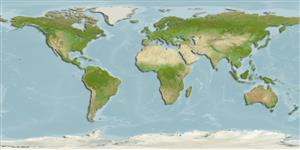Environment: milieu / climate zone / depth range / distribution range
Ecología
marino demersal. Temperate
Distribución
Países | Áreas FAO | Ecosistemas | Ocurrencias, apariciones | Point map | Introducciones | Faunafri
Southwest Pacific: Lord Howe Island, Australia.
Tamaño / Peso / Age
Maturity: Lm ? range ? - ? cm
Max length : 3.2 cm SL macho / no sexado; (Ref. 49352)
Espinas dorsales (total) : 13; Radios blandos dorsales (total) : 10; Espinas anales: 1; Radios blandos anales: 8 - 9; Vértebra: 28. Upper jaw relatively short, 10-11% SL; a stubby fleshy cirrus near distal end of maxilla (Ref. 39602).
Inhabits rock reef (Ref. 75154).
Life cycle and mating behavior
Maturities | Reproducción | Spawnings | Egg(s) | Fecundities | Larva
Poss, S.G., 1999. Aploactinidae. Velvetfishes. p. 2354-2358. In K.E. Carpenter and V.H. Niem (eds.) FAO species identification guide for fishery purposes. The living marine resources of the Western Central Pacific. Vol. 4. Bony fishes part 2 (Mugilidae to Carangidae). Rome, FAO. 2069-2790 p. (Ref. 39602)
IUCN Red List Status (Ref. 130435)
Threat to humans
Harmless
Human uses
Herramientas
Special reports
Download XML
Fuentes de Internet
Estimates based on models
Preferred temperature (Ref.
123201): 20.6 - 22.2, mean 21.5 °C (based on 8 cells).
Phylogenetic diversity index (Ref.
82804): PD
50 = 0.5000 [Uniqueness, from 0.5 = low to 2.0 = high].
Bayesian length-weight: a=0.01000 (0.00244 - 0.04107), b=3.04 (2.81 - 3.27), in cm total length, based on all LWR estimates for this body shape (Ref.
93245).
Nivel trófico (Ref.
69278): 3.2 ±0.3 se; based on size and trophs of closest relatives
Fishing Vulnerability (Ref.
59153): Low vulnerability (10 of 100).
